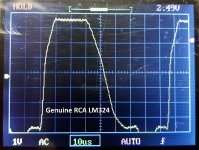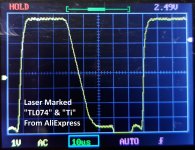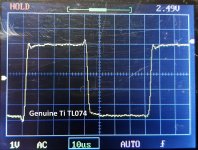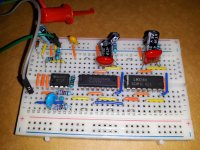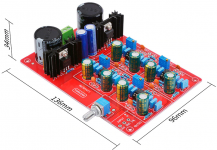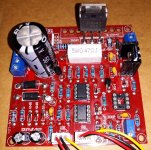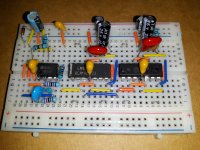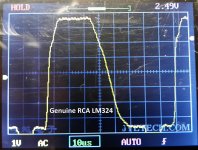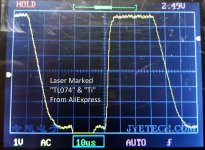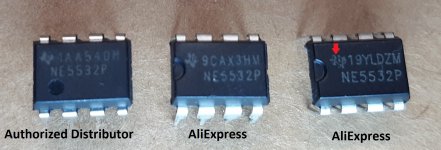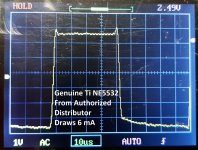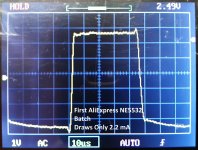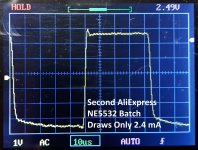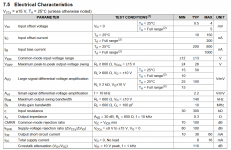I recently bought TL074 from AliExpress and they are not performing as expected.
Can you help identify if they are genuine or fake based upon the voltage follower waveform (square wave input) and the laser marking?
I created an square input signal with an NE555. The output is connected to the TL074 through a 1.1k Ohm resistor. Then for a little level shifting of the input square wave the input of the op amp is connected to Vcc with a 2k Ohm resistor and to GND with another 2k Ohm resistor.
The output is viewed with a $10 DSO138 oscilloscope. An LM317 is used to provide 15V for Vcc.
Outputs from the AliExpress purchased sample (laser marked Ti TL074) are compared with a reference genuine Ti TL074 sample purchased from an authorized distributor. The authorized distributor is Mouser.
The slew rate does not look the same. The AliExpress purchased sample is very very slow. Also the maximum and minimum output voltages are different too. So the voltage follower output signal "signature" is quite different for these AliExpress purchased samples.
Perhaps this simple and low cost test setup can be the basis of a basic fake op-amp detector? Many other DIY members have access to a scope of some sort plus NE555 to create a database of signatures and to compare their own questionable devices.
Can you help identify if they are genuine or fake based upon the voltage follower waveform (square wave input) and the laser marking?
I created an square input signal with an NE555. The output is connected to the TL074 through a 1.1k Ohm resistor. Then for a little level shifting of the input square wave the input of the op amp is connected to Vcc with a 2k Ohm resistor and to GND with another 2k Ohm resistor.
The output is viewed with a $10 DSO138 oscilloscope. An LM317 is used to provide 15V for Vcc.
Outputs from the AliExpress purchased sample (laser marked Ti TL074) are compared with a reference genuine Ti TL074 sample purchased from an authorized distributor. The authorized distributor is Mouser.
The slew rate does not look the same. The AliExpress purchased sample is very very slow. Also the maximum and minimum output voltages are different too. So the voltage follower output signal "signature" is quite different for these AliExpress purchased samples.
Perhaps this simple and low cost test setup can be the basis of a basic fake op-amp detector? Many other DIY members have access to a scope of some sort plus NE555 to create a database of signatures and to compare their own questionable devices.
Attachments
-
 Laser Marking Left TL074 From Authorized Distributor Right From AliExpress.jpg345.1 KB · Views: 811
Laser Marking Left TL074 From Authorized Distributor Right From AliExpress.jpg345.1 KB · Views: 811 -
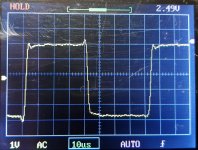 Output of Genuine Ti TL074 Sold By Authorized Distributor.jpg576.1 KB · Views: 749
Output of Genuine Ti TL074 Sold By Authorized Distributor.jpg576.1 KB · Views: 749 -
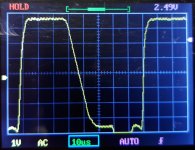 Output Of Op Amp Sold as TL074 on AliExpress.jpg363.1 KB · Views: 658
Output Of Op Amp Sold as TL074 on AliExpress.jpg363.1 KB · Views: 658 -
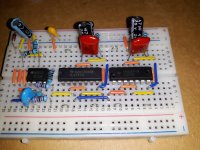 Left TL074 From Authorized Distributor Right From AliExpress.jpg860.6 KB · Views: 1,011
Left TL074 From Authorized Distributor Right From AliExpress.jpg860.6 KB · Views: 1,011
What are your own eyes telling you... But also double check all your connections on that board as something seems very off with that 2nd waveform.
I get the same result if I swap the positions of the genuine "reference" and "under test" op-amp. So it appears that it is the op-amp not the board. Also this is the second test board. The first test board was not as neat looking but gave the exact same results. The other test board is more complicated and holds single, dual and quad op-amps.
With TL074 from mouser being 60p in UK why on earth would you get them from AliExpress?
I have had some success with other components so I thought I would add them to an order of 2W metal film resistors and trimmers. And to some extent it is hard to avoid when buying boards and some DIY projects. A number of times I have bought interesting pre-amplifier and power amplifier boards and have been left wondering about the components on them.
For example, I just received an interesting (nicely designed) pre-amplifier based upon the NE5534. It came with four op-amps marked "NE5534" so I ordered four from Mouser and I am in the process of comparing the ones from Mouser to the ones on the board.
Based upon what I am seeing it is quite likely that I will purchase op-amps and power transistors only from authorized distributors in the future. However since many people buy these components and boards with the components on them it might be helpful if there is something clear to help others reach the appropriate conclusion more rapidly and clearly. It might be necessary for me to simply discard the semiconductors from boards and kits in the future.
They may well be fine.
555 timers were great for simple circuits that ran on there own batteries.
Put one on a common power rail with an analogue circuit and the timing capacitor discharge circuit inside the timer puts pulses as high as an amp onto the rails.
You may be running the op-amps on an out of spec power supply due to this.
Slew rate is easy with a faster scope and an RF sig gen.
Just crank up the frequency until the output of the op-amp becomes a triangle wave and measure the slope.
It should rise at the number of volts per us per volt given in the spec or better.
If a big supplier buys a huge batch of faster op-amps they may well just re-number some to cover orders for slower ones if the demand is low. They are in this case better than spec and in boards where the decoupling capacitors are not close enough to the chip the thing runs into oscillation.
These chips are so cheap now that older parts may well be supplied with an old number on a newer pin compatible part.
Many years ago I built my own function generator and it would not work with fast op-amps for years until I got hold of a strip of SMD ceramic capacitors and fitted them on the track side of the board between the power pins of each chip.
With slow old chips you are more likely to find a faster one hiding under an old number. You will only find this out if you have a badly laid out board otherwise who cares.
What can a manufacturer if the old die wears out and there is a new one that costs much less to operate is churning out millions parts that are just a bit faster and nothing else.
You will notice immediately if you drive one out of spec to create a fuzz pedal.
I would wedge an SMD cap between the pins and use the RF sig gen method. They used to sell flat capacitors that fitted under DIL packages for decoupling where the design engineer had forgotten about power rail decoupling. I have not seen them on sale for years as most boards are churned out from digital files so that it is almost cheaper to scrap and churn out a new batch of boards.
555 timers were great for simple circuits that ran on there own batteries.
Put one on a common power rail with an analogue circuit and the timing capacitor discharge circuit inside the timer puts pulses as high as an amp onto the rails.
You may be running the op-amps on an out of spec power supply due to this.
Slew rate is easy with a faster scope and an RF sig gen.
Just crank up the frequency until the output of the op-amp becomes a triangle wave and measure the slope.
It should rise at the number of volts per us per volt given in the spec or better.
If a big supplier buys a huge batch of faster op-amps they may well just re-number some to cover orders for slower ones if the demand is low. They are in this case better than spec and in boards where the decoupling capacitors are not close enough to the chip the thing runs into oscillation.
These chips are so cheap now that older parts may well be supplied with an old number on a newer pin compatible part.
Many years ago I built my own function generator and it would not work with fast op-amps for years until I got hold of a strip of SMD ceramic capacitors and fitted them on the track side of the board between the power pins of each chip.
With slow old chips you are more likely to find a faster one hiding under an old number. You will only find this out if you have a badly laid out board otherwise who cares.
What can a manufacturer if the old die wears out and there is a new one that costs much less to operate is churning out millions parts that are just a bit faster and nothing else.
You will notice immediately if you drive one out of spec to create a fuzz pedal.
I would wedge an SMD cap between the pins and use the RF sig gen method. They used to sell flat capacitors that fitted under DIL packages for decoupling where the design engineer had forgotten about power rail decoupling. I have not seen them on sale for years as most boards are churned out from digital files so that it is almost cheaper to scrap and churn out a new batch of boards.
What are your own eyes telling you... But also double check all your connections on that board as something seems very off with that 2nd waveform.
I double checked the connections and swapped the parts. Same results.
I went through my parts box and measured my other op-amps and I found that an old RCA LM324 behaves quite a bit like this AliExpress op amp that is laser marked TL074.
In the attached scope image the voltage follower behavior of the old RCA LM324 looks like this AliExpress op amp that is laser marked TL074.
Also I put a very small resistor in the Vcc lines and the current draw matches the LM324. The current draw is much lower than the genuine Ti TL074 reference device that I bought from Mouser.
So the slopes, maximum voltages, glitches and current draw very closely match an LM324. Nothing like the genuine Ti TL074 reference part.
Attachments
With TL074 from mouser being 60p in UK why on earth would you get them from AliExpress?
To help explain why I have enclosed images of a couple of useful devices/boards/DIY kits that I bought from AliExpress.
One is a useful laboratory supply that uses three TL081 that I have setup with two 10 turn potentiometers for voltage and the current limit.
The second is a nicely designed preamplifier that uses four NE5534.
I would like to know that both are using genuine parts. There is not much point in getting a nice preamplifier if it has slow and noisy fake op amps. Also the laboratory supply might be noisy with fake op amps and it might also be unreliable and/or dangerous to the attached equipment.
Based upon my finding it might be necessary for me to conclude that I need to discard all the semiconductors from such kits and boards. (And purchase replacements from authorized distributors.)
I also seriously wonder how many bad reviews of the NE5532/NE5534 or TL071/81/72/82/74/84 are actually reviews of LM358 or LM324 or other fake/rebranded op amps and the reviewer never knew why it sounded bad. After all a huge amount of the most critically acclaimed recordings went through a room full of equipment built with op amps such as the NE5532 and TL072.
Attachments
Last edited:
The lab power supply, I had one, the TL081s weren't and one went up like a firecracker.
The design depends on one TL081 output being clamped to zero volts immediately when the power is turned off, to prevent any spikes in output voltage, and in my case, this was happening continuously due to a bad zener diode.
Genuine TL081 has output protection and therefore it survives. Whatever they'd put in did not. Also on this board they run damn close to the absolute maximum specified rail voltage.
Probably if not for the faulty zener, it would have been ok for a while.
I changed the power transistor at the same time, on the assumption it was also fake.
The design depends on one TL081 output being clamped to zero volts immediately when the power is turned off, to prevent any spikes in output voltage, and in my case, this was happening continuously due to a bad zener diode.
Genuine TL081 has output protection and therefore it survives. Whatever they'd put in did not. Also on this board they run damn close to the absolute maximum specified rail voltage.
Probably if not for the faulty zener, it would have been ok for a while.
I changed the power transistor at the same time, on the assumption it was also fake.
The lab power supply, I had one, the TL081s weren't and one went up like a firecracker.
The design depends on one TL081 output being clamped to zero volts immediately when the power is turned off, to prevent any spikes in output voltage, and in my case, this was happening continuously due to a bad zener diode.
I built a couple of those supplies to make a current limited dual output laboratory supply. One blew up the "TL081" also. Then to add insult to injury the replacement "TL081" I ordered from another source turned out to be fake too.
The problem with all of this is that there are good "designs" out there such as useful and needed power supplies and pre-amplifiers (and power amplifiers). However the fake op-amps, power transistors and even capacitors can really ruin it. Right now I assume I need to toss the power transistors, op-amps and important capacitors. So far I have been ok with diodes and small signal bipolars. So the assembled boards and the DIY kits are really a source of a board, resistors and some of the capacitors and some of the small transistors. (And connectors and potentiometers.)
I changed the power transistor at the same time, on the assumption it was also fake.
That is on my list to do. In a test fixture clamped to a huge heatsink I did some SOA tests up to 64W dissipation. I also built a test fixture to test Vcbo up to 106V.
They may well be fine.
555 timers were great for simple circuits that ran on there own batteries.
Put one on a common power rail with an analogue circuit and the timing capacitor discharge circuit inside the timer puts pulses as high as an amp onto the rails.
You may be running the op-amps on an out of spec power supply due to this.
Slew rate is easy with a faster scope and an RF sig gen.
Just crank up the frequency until the output of the op-amp becomes a triangle wave and measure the slope.
It should rise at the number of volts per us per volt given in the spec or better.
If a big supplier buys a huge batch of faster op-amps they may well just re-number some to cover orders for slower ones if the demand is low. They are in this case better than spec and in boards where the decoupling capacitors are not close enough to the chip the thing runs into oscillation.
These chips are so cheap now that older parts may well be supplied with an old number on a newer pin compatible part.
Many years ago I built my own function generator and it would not work with fast op-amps for years until I got hold of a strip of SMD ceramic capacitors and fitted them on the track side of the board between the power pins of each chip.
With slow old chips you are more likely to find a faster one hiding under an old number. You will only find this out if you have a badly laid out board otherwise who cares.
What can a manufacturer if the old die wears out and there is a new one that costs much less to operate is churning out millions parts that are just a bit faster and nothing else.
You will notice immediately if you drive one out of spec to create a fuzz pedal.
I would wedge an SMD cap between the pins and use the RF sig gen method. They used to sell flat capacitors that fitted under DIL packages for decoupling where the design engineer had forgotten about power rail decoupling. I have not seen them on sale for years as most boards are churned out from digital files so that it is almost cheaper to scrap and churn out a new batch of boards.
The op amps have two local bypass capacitors and then a low value sense resistor to Vcc and then there is another bypass capacitor for each chip.
However I considered your advice and to be safe I soldered ceramic (monolithic) 4.7uF bypass capacitors directly to the leads of the NE555 and to each of the op amps. I did not observe any change in the scope waveforms so I believe we are ok on the bypassing.
My guess is that these are just LM324 type.
From a few google searches it appears that others have bought various op amps to find that they seem to be just 1458/358/324 types and not what the laser marking says.
Attachments
Today I got around to testing two batches of dual op amps marked "NE5532".
They are marked 9CAX3HM and 19YLDZM. (Anyone else seen these?)
At first they look quite a bit like genuine Ti NE5532 from an authorized distributor. The signature of the voltage follower output looks really similar to an NE5532.
But the real NE5532 draws 6 mA. The ones purchased from AliExpress draw 2.2 mA and 2.4 mA. That seems to be too much of a spread? What do you think? Ever seen real NE5532 with such low currents?
From the laser marking (attached) and the very low currents should we conclude that these are fake too?
They are marked 9CAX3HM and 19YLDZM. (Anyone else seen these?)
At first they look quite a bit like genuine Ti NE5532 from an authorized distributor. The signature of the voltage follower output looks really similar to an NE5532.
But the real NE5532 draws 6 mA. The ones purchased from AliExpress draw 2.2 mA and 2.4 mA. That seems to be too much of a spread? What do you think? Ever seen real NE5532 with such low currents?
From the laser marking (attached) and the very low currents should we conclude that these are fake too?
Attachments
Last edited:
But the real NE5532 draws 6 mA. The ones purchased from AliExpress draw 2.2 mA and 2.4 mA. That seems to be too much of a spread? What do you think? Ever seen real NE5532 with such low currents?
Nope, definitely they're fake. I only a couple of days ago checked the supply current of some Taobao AD811JR I'd bought a while back. I measured about 7mA - I concluded they're fake as the DS typical is over double that.
Hello,
Quick question for
could post your test diagram of the TL074 that you used to control the rise time of this one? I have a TL074 which works for a standard LED-based tester (which flashes if everything is ok), but in reality this TL has a fault in the circuit. I would like to highlight the latter by measurements and tests.
Thanks in advance.
Quick question for
could post your test diagram of the TL074 that you used to control the rise time of this one? I have a TL074 which works for a standard LED-based tester (which flashes if everything is ok), but in reality this TL has a fault in the circuit. I would like to highlight the latter by measurements and tests.
Thanks in advance.
- Home
- Design & Build
- Parts
- Fake Op Amp Tester? My Op Amps Genuine or Fake?
